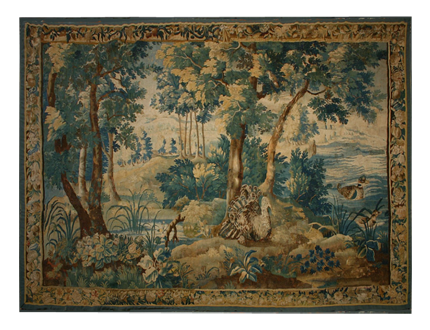Object Descriptions Ground Floor Parlor
Tapestry
Many well-to-do Elizabethans, like other Europeans, would have had tapestries on their walls, both for decoration and for the purpose of keeping their rooms warm. Many tapestries were woven in France and the Netherlands. We do not know the true extent of Spenser’s household goods or “disposable income,” nor whether or not he could afford such luxuries. Odds are that the cost of setting up the basics of a household at Kilcolman would have devoured most if not all that he had. Wealthy patrons like Raleigh or his neighbors the Norrises, who built a huge house at Mallow, County Cork, would have had more to invest in their household goods.
The tapestry here is a generic example of one that displays a pastoral/wooded landscape. Another tapestry, with floral motifs, hangs in the Tower House Parlor.

Literary Connections
Tapestries might tell stories derived from myth, legend and literature. In a well-known episode in Book III, canto xi of The Faerie Queene, the heroine of chastity, Britomart, enters the evil House of Busyrane and travels through a room decorated with many gold- and silk-threaded tapestries depicting amorous scenes:
For round about, the walls yclothed were
With goodly arras of great maiesty,
Wouen with gold and silke so close and nere,
That the rich metall lurked priuily,
As faining to be hidd from enuious eye;
Yet here, and there, and euery where vnwares
It shewd it selfe, and shone vnwillingly;
Like to a discolourd Snake, whose hidden snares
Through the greene gras his long bright burnisht back declares.And in those Tapets weren fashioned
Many faire pourtraicts, and many a faire feate,
And all of loue, and all of lusty-hed,
As seemed by their semblaunt did entreat;
And eke all Cupids warres they did repeate,
And cruell battailes, which he whilome fought
Gainst all the Gods, to make his empire great;
Besides the huge massacres, which he wrought
On mighty kings and kesars, into thraldome brought.Therein was writt, how often thondring Ioue
Had felt the point of his hart percing dart,
And leauing heauens kingdome, here did roue
In straunge disguize, to slake his scalding smart;
Now like a Ram, faire Helle to peruart,
Now like a Bull, Europa to withdraw:
Ah, how the fearefull Ladies tender hart
Did liuely seeme to tremble, when she saw
The huge seas vnder her t’obay her seruaunts law. (FQ III.xi.28-30)
Busyrane’s majestic tapestries tell the same kinds of stories as the epic itself. They stress the power of love and desire (or “Cupids warres”) to conquer all.
Bibliography:
Christopher Burlinson, Allegory, Space and the Material World in the Writings of Edmund Spenser (Cambridge: D.S. Brewer, 2006), ch. 3 (“Galleries: Space, Mythography, and the Object”).
Michael L. Donnelly, “tapestries.” The Spenser Encyclopedia. Ed. A. C. Hamilton (Toronto: U of Toronto P, 1990), 677-8.
Jane Grogan, Exemplary Spenser: visual and poetic pedagogy in The Faerie Queene (Aldershot: Ashgate, 2009): 117-126.
Links:
www.metmuseum.org/Collections/search-the-collections/70007568
[accessed 10/30/12]
[famous unicorn tapestries in the Cloisters, Metropolitan Museum of Art, NY]